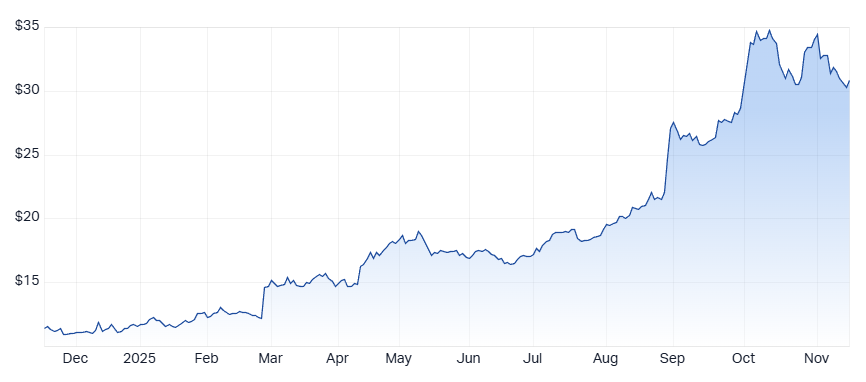When markets get tricky, you need horsepower. VanEck's ALFA has it
Please note, this interview was filmed Thursday, 6 November 2025
The recent bout of market volatility is precisely why I've always liked long/short strategies. Executed well, they allow you to participate in most of the upside when it occurs, whilst also protecting you from the worst of the downside when it inevitably arrives.
So, in a market crowded with ETFs of every flavour, when VanEck launched its Australian Long/Short Complex ETF (ALFA), it immediately landed on my radar.
Part of the appeal is the simple fact that long/short strategies are not easy to implement. They require both conviction and discipline. But what really intrigued me, and what ultimately forms the backbone of ALFA, is the way VanEck have blended quantitative horsepower with a fundamental framework - both of which continuously evolve. This isn’t a “set and forget” rulebook. It’s a living, learning engine running thousands of signals, hunting for mispricing across every corner of the ASX.
As Chesler puts it:
“Our quant platform runs thousands of these signals… updating the information constantly and really that’s how we stay ahead of the curve.
It can really adapt instantly, or very quickly, to changes in the market environment.”
That line captures why ALFA stands out. The market is moving fast, from macro shifts to sector rotations to the micro nuances of cashflow quality, and a strategy that adapts that quickly is, at the very least, worth understanding.
So in this conversation with Russel Chesler, Jamie Hannah, and Cameron McCormack, we go beyond the buzzwords and pull apart the machinery behind ALFA: how it works, what it owns (and has been shorting), the environment it’s operating in, and the signals driving the ETF’s strongest calls so far. Whether you’re long/short-curious or just want a fresh lens on the Australian equity market, this one won’t disappoint.

INTERVIEW SUMMARY
Setting the scene
VanEck’s ALFA ETF marks the firm’s push into systematic long/short investing on the ASX. Hannah describes it as “an Australian equity long short fund… utilising some of the world’s most advanced computing power,” blending regenerative learning with VanEck’s smart beta heritage.
Unlike a plain-vanilla index ETF, ALFA actively ranks ASX companies and uses leverage - 130% long, 30% short - to capture upside while exploiting opportunities on the short side.
Chesler highlights VanEck’s DNA in quantitative design. The smart beta groundwork laid through products like the VanEck Australian Equal Weight ETF (MVW) and the VanEck MSCI International Quality ETF (QUAL) provides the foundation for ALFA’s signal-driven architecture.
Market environment and the case for long/short
McCormack frames the backdrop: the ASX 200 is up nearly 13% over 12 months (at the time of recording), large caps look stretched, and dispersion across sectors is extreme: almost 50% from top to bottom.
With valuations elevated and small caps littered with “junkier” names, McCormack argues the current environment rewards selectivity and punishes complacency. A systematic long/short strategy is well placed to exploit these divergences.
How the engine works
ALFA’s signal platform spans three major baskets:
- Company and industry fundamentals: From return on equity to sector-specific metrics like inventory levels for retailers or passenger flows for airlines.
- Technicals and pair trading: Examining price momentum, divergences between related sectors, and behavioural patterns across the index.
- Macro signals: Shifts in growth, inflation, services inflation, goods inflation, and conditions that favour either quality or small caps.
Each ASX 300 stock is ranked based on the scores it receives from the analytical process. High scorers become longs; the lowest become shorts. As Chesler explains, this process is continuous, adaptive, and deeply data-driven.
Portfolio construction and risk controls
ALFA typically holds 15–50 longs and up to 25 shorts. At the time of filming, it held 18 longs and 15 shorts.
Risk limits apply at both the stock and sector level, and the short book has a dedicated stop-loss protocol. The structural leverage comes from the 130/30 model, where the ETF buys $130 of stock for every $100 invested, funded by shorting $30 of shares.
Performance and the signals behind it
Since launching in January, ALFA has returned 12.3% to end-October, beating the ASX 200 Accumulation Index by 3.5%. Hannah credits consistent overweights in gold miners, industrials and selective consumer discretionary names, all supported by fundamental and technical signals.
McCormack expands on the drivers: improving free cashflow margins; resilient macro data (GDP and retail sales ticking up) for the longs; and deteriorating cashflows and rising leverage among short candidates. These factors have materially influenced both sides of the book.
Stock examples: winners and shorts
The discussion becomes most compelling when the team drill into specific names.
Technology One (ASX: TNE) (long):

Hannah calls it “a standout performer in the first half of the year.”
The company delivered first-half profit growth of 33%, expanding cashflow margins while increasing sales. Low debt, strong momentum and entrenched software across universities and councils made it an ideal long candidate.
CSL Limited (ASX: CSL) (short):

McCormack outlines why CSL has struggled:
“A persistent deterioration in enterprise value relative to their cashflow and also sales growth.”
Despite appearing “cheap” on some metrics, headline growth has softened, the China vaccine spinoff has created uncertainty, and R&D spend hasn’t translated into sales momentum. ALFA entered the short in July and benefited from two major share price drops, including the largest since 1999.
Eagers Automotive (ASX: APE) (long):

Chesler highlights this as the top performer, doubling since July. Revenue rose 19% at the half-year, with strong earnings stability and momentum aided by partnerships with BYD and Mitsubishi. Its EV distribution footprint - 31% of EVs sold in Australia - and improving household financial conditions offer further upside.
Role in a portfolio
ALFA’s unconstrained, systemic, style-agnostic nature makes it a complementary satellite to a traditional long-only equity allocation. Chesler describes it as flexible by design, capable of participating in a variety of market cycles.
As the panel looks toward 2026, Hannah sums up ALFA’s objective:
“Alpha aims to harvest outperformance in all market conditions.”

5 topics
3 stocks mentioned
2 contributors mentioned
